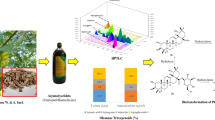Abstract
The objective of this work was to screen and identify permeable components of Radix et Rhizoma Rhei extract by use of immobilized artificial membrane chromatography (IAMC) then to investigate the intestinal absorption behavior of these components and the mechanism of absorption at three concentrations (0.3, 0.6, and 1.5 mg mL−1) by use of the in situ rat intestinal absorption model. The percentage absorption of permeable components was then correlated with their retention behavior by using mobile phases of three different pH (5.0, 6.0, and 7.0) containing buffers of two different ionic strength (10 and 50 mmol L−1). There was better correlation between percentage intestinal absorption and IAMC retention at pH 6.0 (r 2 = 0.82) than at pH 5.0 (r 2 = 0.64) or 7.0 (r 2 = 0.74). The correlation coefficients suggest that most of the permeable components of Radix et Rhizoma Rhei were mainly absorbed by a passive diffusion mechanism. The four main permeable components were identified as rhein, aloe-emodin, chrysophanol, and emodin by comparison of chromatographic and spectrometric behavior with those of reference standards. IAMC seems useful as a promising rapid screening technique for identification of bioactive components in complex systems, e.g. traditional Chinese medicines.




Similar content being viewed by others
References
Robert SA (2003) Curr Opin Drug Discov Dev 6:66–80
Sun J, Wu X, Lu R, Liu JF, Wang YJ, He ZG (2008) Curr Drug Metab 9:152–166
Ong SW, Liu HL, Pidgeon C (1996) J Chromatogr A 728:113–128
Taillardat-Bertschinger A, Carrupt PA, Barbato F, Testa B (2003) J Med Chem 46:655–665
Ong S, Liu H, Qiu X, Bhat G, Pidgeon C (1995) Anal Chem 67:755–762
Nasal A, Sznitowska M, Bucifiski A, Kaliszan R (1995) J Chromatogr A 692:83–89
Pidgeon C, Ong S, Liu H, Qiu X, Pidgeon M, Dantzig AH, Munroe J, Hornback WJ, Kasher JS, Glunz L, Szczerba T (1995) J Med Chem 38:590–594
Sun J, Sakai S, Tauchi Y, Deguchi Y, Cheng G, Chan J, Morimoto K (2003) Eur J Pharm Biopharm 56:223–229
Kotecha J, Shah S, Rathod I, Subbaiah G (2008) Int J Pharm 360:96–106
White RE (2000) Annu Rev Pharmacol Toxicol 40:133–157
Wang HL, Zou HF, Kong L, Ni J (2000) J Basic Clin Physiol Pharmacol 11:155–172
Brasitus TA, Dudeja PK, Dahiya R, Halline A (1987) Biochem J 248:455–461
Beigi F, Gottschalk CL, Hagglund L, Brekkan E, Zhang YX, Osterberg T, Lundahl P (1998) Int J Pharm 164:129–137
Kong L, Zou H, Wang H, Ni J, Zhang Y (2000) Chem J Chin Univ 21:36–40
Sheng LH, Li P, Zou HF (2005) Chin J Anal Chem 33:14–18
Zhou X, Song B, Jin L, Hu D, Diao C, Xu G, Zou Z, Yang S (2006) Bioorg Med Chem Lett 16:563–568
Su HY, Chemg SH, Chen CC (1995) Mutat Res 329:205–212
Zhang L, Chang CJ, Bacus SS (1995) Cancer Res 55:3890–3896
Acknowledgment
We are grateful for financial support from the National Natural Science Foundation of China (nos. 30400563 and 30672556) and the Natural Science Foundation of Liaoning Province (nos 20052058 and 20062058).
Author information
Authors and Affiliations
Corresponding authors
Rights and permissions
About this article
Cite this article
Zhang, W., Sun, J., Wang, Y. et al. Screening and Identification of Permeable Components of Radix et Rhizoma Rhei Extract by Use of Immobilized Artificial Membrane Chromatography. Chroma 70, 1321–1326 (2009). https://doi.org/10.1365/s10337-009-1342-2
Received:
Revised:
Accepted:
Published:
Issue Date:
DOI: https://doi.org/10.1365/s10337-009-1342-2



